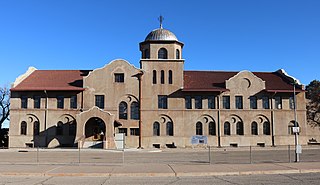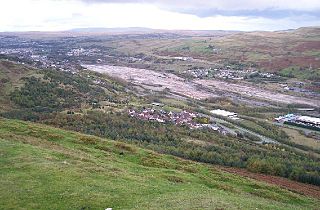
Steelmaking is the process of producing steel from iron ore and/or scrap. In steelmaking, impurities such as nitrogen, silicon, phosphorus, sulfur and excess carbon are removed from the sourced iron, and alloying elements such as manganese, nickel, chromium, carbon and vanadium are added to produce different grades of steel.
Algoma Steel Inc. is an integrated primary steel producer located on the St. Marys River in Sault Ste. Marie, Ontario, Canada. Its products are sold in Canada and the United States as well as overseas. Algoma Steel was founded in 1902 by Francis Clergue, an American entrepreneur who had settled in Sault Ste. Marie. The company emerged from bankruptcy protection in 2004. In April 2007, Algoma Steel was purchased by India's Essar Group for US$ 1.63 billion, continuing operations as a subsidiary known as Essar Steel Algoma Inc. It was purchased again in 2017, by a group of US investors.

A steel mill or steelworks is an industrial plant for the manufacture of steel. It may be an integrated steel works carrying out all steps of steelmaking from smelting iron ore to rolled product, but may also be a plant where steel semi-finished casting products are made from molten pig iron or from scrap.
Anthracite iron or anthracite pig iron is iron extracted by the smelting together of anthracite coal and iron ore, that is using anthracite coal instead of charcoal in iron smelting. This was an important technical advance in the late-1830s, enabling a great acceleration of the Industrial Revolution in the United States and in Europe.

An ironworks or iron works is an industrial plant where iron is smelted and where heavy iron and steel products are made. The term is both singular and plural, i.e. the singular of ironworks is ironworks.
Wheeling-Pittsburgh Steel was a steel manufacturer based in Wheeling, West Virginia.
IISCO Steel Plant of Steel Authority of India Limited is an integrated steel plant located at Burnpur, a neighbourhood in Asansol city, in the Asansol subdivision of Paschim Bardhaman district, West Bengal, India.

The Colorado Fuel and Iron Company (CF&I) was a large steel conglomerate founded by the merger of previous business interests in 1892. By 1903 it was mainly owned and controlled by John D. Rockefeller and Jay Gould's financial heirs. While it came to control many plants throughout the country, its main plant was a steel mill on the south side of Pueblo, Colorado, and was the city's main industry for most of its history. From 1901 to 1912, Colorado Fuel and Iron was one of the Dow Jones Industrials. The steel-market crash of 1982 led to the decline of the company. After going through several bankruptcies, the company was acquired by Oregon Steel Mills in 1993, and changed its name to Rocky Mountain Steel Mills. In January 2007, Rocky Mountain Steel Mills, along with the rest of Oregon Steel's holdings, were acquired by EVRAZ Group, a Russian steel corporation, for $2.3 billion.
Seend Ironstone Quarry and Road Cutting is a 3 acres (1.2 ha) Geological Site of Special Scientific Interest at Seend in Wiltshire, England, notified in 1965. The site contains facies of Lower Greensand containing specimens of fauna not found elsewhere.
The United Steel Companies was a steelmaking, engineering, coal mining and coal by-product group based in South Yorkshire and Lincolnshire, England.

The Ravenscraig steelworks, operated by Colvilles and from 1967 by British Steel Corporation, consisted of an integrated iron and steel works and a hot strip steel mill. They were located in Motherwell, North Lanarkshire, Scotland.

The Tennessee Coal, Iron and Railroad Company (1852–1952), also known as TCI and the Tennessee Company, was a major American steel manufacturer with interests in coal and iron ore mining and railroad operations. Originally based entirely within Tennessee, it relocated most of its business to Alabama in the late nineteenth century, following protests over its use of free convict labor. With a sizable real estate portfolio, the company owned several Birmingham satellite towns, including Ensley, Fairfield, Docena, Edgewater and Bayview. It also established a coal mining camp it sold to U.S. Steel which developed it into the Westfield, Alabama planned community.
The Duluth Works was an industrial steel and cement manufacturing complex located in Duluth, Minnesota, United States, in operation 1915 to 1987. The complex was operated by the United States Steel Corporation. Officially, the plant's purpose was to supply the growing Midwest with steel finished products. Unofficially, they were built as part of a "gentleman's agreement" between U.S. Steel and the State of Minnesota to not impose hefty iron ore taxes on U.S. Steel in exchange for a fully integrated steel plant within Minnesota, whose mines furnished 80% of the ore to U.S. Steel. The combined works of the steel and cement plant were the largest employers in Duluth and the fourth largest industrial complex in Minnesota.

The Teesside Steelworks was a large steelworks that formed a continuous stretch along the south bank of the River Tees from the towns of Middlesbrough to Redcar in North Yorkshire, England. At its height there were 91 blast furnaces within a 10-mile radius of the area. By the end of the 1970s there was only one left on Teesside. Opened in 1979 and located near the mouth of the River Tees, the Redcar blast furnace was the second largest in Europe.
The Woodward Iron Company was founded on December 31, 1881, by brothers William and Joseph Woodward. William was the company president and Joseph was the company secretary. The company operated iron and coal mines, quarries and furnaces; these were connected by a private industrial railroad based in Bessemer, Alabama. The company administrative office was located near Woodward Ore Mine #1, south of Paul's Hill in Bessemer.

Ebbw Vale Steelworks was an integrated steel mill located in Ebbw Vale, South Wales. Developed from 1790, by the late 1930s it had become the largest steel mill in Europe. It was nationalised after World War II. As the steel industry changed to bulk handling, iron and steel making was ceased in the 1970s, and the site was redeveloped as a specialised tinplate works. It was closed by Corus in 2002, but is being redeveloped in a joint partnership between Blaenau Gwent Council and the Welsh Government.
In 2022, the United States was the world’s third-largest producer of raw steel, and the sixth-largest producer of pig iron. The industry produced 29 million metric tons of pig iron and 88 million tons of steel. Most iron and steel in the United States is now made from iron and steel scrap, rather than iron ore. The United States is also a major importer of iron and steel, as well as iron and steel products.
The Clyde Iron Works was a Scottish-based ironworking plant which operated from 1786 to 1978.

The Lithgow Blast Furnace is a heritage-listed former blast furnace and now park and visitor attraction at Inch Street, Lithgow, City of Lithgow, New South Wales, Australia. It was built from 1906 to 1907 by William Sandford Limited. It is also known as Eskbank Ironworks Blast Furnace site; Industrial Archaeological Site. The property is owned by Lithgow City Council. It was added to the New South Wales State Heritage Register on 2 April 1999.









